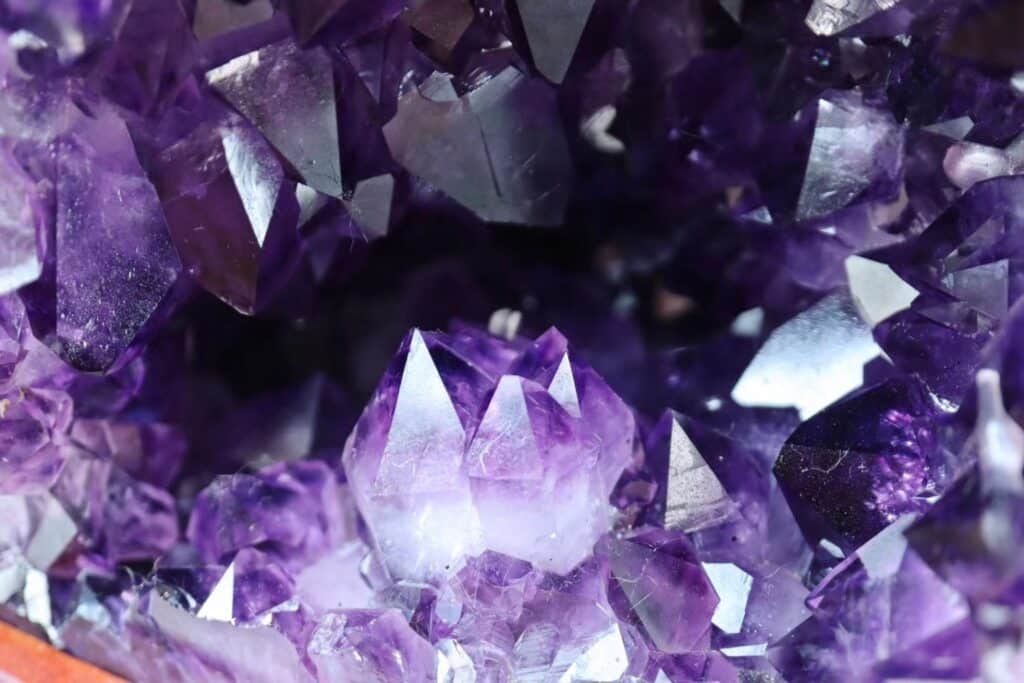This article is the third article about the introduction of jade roller & gua sha raw materials. Earlier we talked about white crystal and rose quartz. Today we will learn about the most expensive and most beautiful of all scraping raw materials, amethyst, which belongs to the crystal family.
Amethyst has the highest average value among all crystals, so the gua sha made from it is also the most expensive.
What is Amethyst?

Amethyst’s main color can be light violet to deep purple. It has the potential to display one or both subtones of red and blue. The best amethysts come from Siberia, Sri Lanka, Brazil and the Far East. The ideal quality amethyst is called “Deep Siberian” and has 75-80% violet primary tone and 15-20% blue and (depending on lighting conditions) red secondary tone.
The research shows that the source of the color of amethyst is that the trace elements with large ionic radius existing in the silica structure are replaced by ferric ions (Fe3+) under the action of radiation. And to a certain extent, the color of amethyst can develop naturally, even with very low levels of iron. Natural amethyst has the dichroism of purplish red and blue-purple, but it will turn into orange-yellow, brownish yellow or dark brown after heating, similar to citrine, but it will lose its dichroism, which is different from natural citrine. When partially heated, amethyst transforms into ametrine. Amethyst will fade if exposed to light for too long, but will deepen when irradiated again.
Properties
Color: purple, violet
Crystal habit: hexagonal prism with hexagonal pyramids at both ends (typical)
Crystal system: Trigonal system Category 32
Twin Crystals: Dauphin Law, Brazilian Law and Japanese Law
Cleavage: none
Fracture: Shell-shaped
Mohs hardness: 7, less than 7 for impure samples
gloss: glass
Streak: white
Transparency: Transparent to translucent
Specific gravity: 2.65; impure samples vary
Optical Properties: Uniaxial (+)
Refractive index: nω = 1.543–1.553
nε = 1.552–1.554
Birefringence: +0.009 (B-G interval)
pleochroism: none
Melting point: 1650±75 °C
Solubility: Insoluble in common solvents
History of Amethyst:

Amethyst was used as a gemstone by the ancient Egyptians and was often used as an intaglio gemstone in ancient times.
The ancient Greeks believed that amethyst could make people not drunk. Medieval European soldiers believed that wearing amethyst amulets in battle would heal wounds and have a calming effect. Granular amethysts have been found in Anglo-Saxon tombs in England. Western Catholic bishops usually wear church rings inlaid with amethyst.
Crystal Healing of Amethyst
For transformation and transmutation of challenging situations.
The purple vibe is powerful, so use this purple quartz crystal to set the intention that you are safe and sound. Remember that you can always choose to be divinely protected, and you will be. Positive Affirmation: I am divinely protected. I am grateful that I feel safe and secure wherever I am and wherever I go.
To stimulate the third eye and all six “clairs,” or sensory gifts: clairvoyance, clairaudience, claircognizance, clairsentience, clairolfaction, and clairgustation. These are terms for the abilities to spiritually see, hear, know, sense, smell, and taste the truth. Use this purple-toned quartz to ward off nightmares and encourage sweet dreams and restful sleep. Positive Affirmation: I use my intuition and follow my hunches. I pay attention to my dreams and interpret their messages easily.